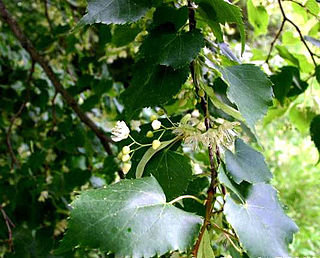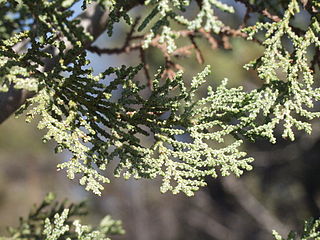
Tilia cordata, the small-leaved lime or small-leaved linden, is a species of tree in the family Malvaceae, native to much of Europe. Other common names include little-leaf or littleleaf linden, or traditionally in South East England, pry or pry tree. Its range extends from Britain through mainland Europe to the Caucasus and western Asia. In the south of its range it is restricted to high elevations.

Quercus agrifolia, the California live oak, or coast live oak, is an evergreen live oak native to the California Floristic Province. Live oaks are so-called because they keep living leaves on the tree all year, adding young leaves and shedding dead leaves simultaneously rather than dropping dead leaves en masse in the autumn like a true deciduous tree. Coast live oaks may be shrubby, depending on age and growing location, but is generally a medium-sized tree. It grows west of the Sierra Nevada mountain range from Mendocino County, California, south to northern Baja California in Mexico. It is classified in the red oak section of oaks.

Cathaya is a genus in the pine family, Pinaceae, with one known living species, Cathaya argyrophylla. Cathaya is a member of the subfamily Laricoideae, most closely related to Pseudotsuga and Larix. A second species, C. nanchuanensis, is now treated as a synonym, as it does not differ from C. argyrophylla in any characters.

Abarema is a neotropical genus in the family Fabaceae. It is native to Brazil, Cuba, and Venezuela. Most of the species can be found in the Amazon Basin and the Guyana Highlands. They have a deep-green fernlike foliage, with bipinnately compound leaves.

Cephalanthera longifolia, the narrow-leaved helleborine, sword-leaved helleborine or long-leaved helleborine, is a rhizomatous herbaceous perennial plant in the family Orchidaceae. It is native to light woodland, and widespread across Europe, Asia and North Africa from Ireland and Morocco to China. This includes the United Kingdom, Iran, Russia, Kazakhstan, Turkey, Algeria, India, Pakistan, Germany, Italy, France, Spain, Portugal and many other countries.

Hesperocyparis macnabiana is a species of western cypress in from California that was previously named Cupressus macnabiana.

Abarema centiflora is a species of plant in the family Fabaceae. It is endemic to the east slope of the Bolivian Andes. It is a small tree found in humid montane forests.

Abarema cochliocarpos is a species of tree in the legume family, Fabaceae. Its common name is barbatimão. It is endemic to Brazil, where it occurs in Alagoas, Bahia, Paraíba, Pernambuco, Rio de Janeiro, Rio Grande do Norte and São Paulo.
Abarema glauca, the glaucous abarema, is a tree species in the legume family (Fabaceae). It is found in the Bahamas, Cuba, and Hispaniola. Abarema glauca is found most easily on the east coast of Dominican Republic, in Uvero Alto, north of Punta Cana.
Schoepfia harrisii is a species of flowering plant in the Schoepfiaceae family. It is a small tree or shrub, growing two to five metres tall. It is endemic to Jamaica, where it is only known to occur in the parishes of Trelawny and Clarendon, in what is known as Cockpit Country, a region of many steep, rounded, limestone hills, shaped like an egg-carton. Here it grows on crags in moist woodland, between 600 and 900m in elevation.
Schoepfia multiflora is a species of flowering plant in the Schoepfiaceae family. It is a smallish tree, growing six to eight metres tall, exceptionally to ten metres. It is endemic to Jamaica, where it grows on rocky limestone in the woodlands of the central region.

Eucalyptus urophylla, commonly known as Timor white gum, Timor mountain gum, popo or ampupu, is a species of eucalypt native to islands of the Indonesian Archipelago and Timor.

Abarema adenophora is a species of plant in the family Fabaceae. It is native to Northern South America, Costa Rica, and Nicaragua.
Abarema alexandri is a species of plant of the genus Abarema in the family Fabaceae. It is endemic to Jamaica, where it can be found in woodland or thicket on limestone soils.

Pyrus cordata, the Heart-leaved pear or Plymouth pear, is a rare wild species of pear belonging to the family Rosaceae. It gets its name in Spanish, Portuguese and French from the shape of its leaves. In the UK, it is known as Plymouth Pear after the city of Plymouth in Devon, where it was originally found in 1870 The Plymouth pear was one of the British trees to be funded under English Natures Species Recovery Programme.
Schrebera trichoclada, the wing-leaved wooden pear, is a plant in the family Oleaceae.
Abarema alexandri var. troyana is a variety of the legume A. alexandri in the family Fabaceae. It is endemic to Jamaica, where it can be found in woodland or thicket on limestone soils.

Terminalia hadleyana is a tree of the family Combretaceae native to northern Australia.

Protea lorifolia, in English called the strap-leaved sugarbush, strap-leaved protea or strap-leaf sugarbush is a flowering shrub which belongs to the genus Protea.
Walsura monophylla is a plant in the family Meliaceae, native to the Philippines.













